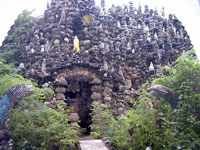Bản tin đăng tải trên trang Web The Buddhist Channel ngày 17 tháng 11, 2005
Chùa Từ Vân xây dựng vào năm 1968 trên con đường Ba Tháng Tư, khoảng 60 km về phía nam Nha Trang. Trong 10 năm qua, những vị tu sĩ đã dùng san hô chết và vỏ ốc để xây dựng nhiều công trình khác nhau, biến ngôi chùa trở thành một viện bảo tàng san hô và vỏ ốc.
Trước tiên du khách sẽ thăm viếng thuyền Bát Nhã nằm tại lối vào chính của ngôi chùa. Ði xuyên qua khu vườn phía trước, du khách sẽ gặp ngôi tháp Bảo Tích cao 40 metre, được xây dựng bằng xi măng cùng vỏ sà cừ và vỏ ốc. Hàng trăm pho tượng Phật và chư Thiên được tôn trí chung quanh ngọn tháp trong khi bên trong là một pho tượng Bồ tát Quán Âm thiên thủ thiên nhãn.
Bát Nhã Hoa Viên, một khu vườn rộng lớn đầy cây to bóng mát và hình tượng các loài cầm thú cùng sinh vật biển, một khung cảnh kỳ mỹ dung hòa với môi trường chung quanh bên cạnh ngôi bảo tháp.
Nhưng cái thật sự khêu gợi lòng hiếu kỳ của du khách là công trình có tên gọi Ðường Xuống Ðịa Ngục. Con đường còn đang trong tiến trình xây dựng, phải mất một thời gian lâu vài năm để hoàn tất con đường uốn khúc 1 km dẫn đến một hang động tượng trưng cho địa ngục, cả hai đều được xây dựng bằng san hô chết và vỏ ốc.
Trước khi đặt chân lên con đường nhỏ, xin đề nghị du khách thắp nến lên và siết chặt mũ an toàn để tránh đá lỏm chỏm trên trần hang động. Một khi vào bên trong, lối đi sẽ thâu hẹp và có nhiều gió lộng , đôi khi lối đi sẽ cong quẹo theo một hình dạng xoắn ốc.
Có 12 cổng trong hang động biểu trưng của 12 tầng địa ngục trong truyền thuyết Phật giáo, mỗi cổng là một miêu tả của tội lỗi mà một con người có thể phạm phải trong suốt cuộc đời của họ.
Những ai không dám mạo hiểm đi một mình thì có thê hỏi nhờ người hướng dẫn từ những đứa trẻ cư ngụ nơi đó, những đứa trẻ biết rành rẽ con đường giống như mặt trái của bàn tay. Khi rời khỏi hang động, đừng quên biếu chúng một ít thù lao cho việc phục vụ.
Tu Van Pagoda: A world of corals and shells
Saigon, Vietnam -- A magnificent, mysterious realm of dry corals and shells distinguishes Tu Van Pagoda on the central coast from Vietnam’s many other pagodas. With its distinct origins, the pagoda, located in Cam Ranh Municipality of Khanh Hoa Province, has become a popular stopover on many tours from HCMC to Nha Trang, the capital of Khanh Hoa.

Tu Van Pagoda was built in 1968 on Ba Thang Tu Street, some 60 kilometers south of Nha Trang. In past decades, monks at the pagoda have been using dead corals and seashells to build many different works, turning the pagoda’s space into a museum of corals and shells.
The first thing visitors will encounter is the Thuyen Bat Nha (Prajna Paramitta Boat), resting at the main entrance of the pagoda. According to Buddhist theory, it is a boat navigated by Mitreya Buddha to carry persons of great righteousness and generosity across the ocean of misery after death. On the boat’s sails are extracts from the Buddhist book of prayer, intended to calm visitors so that they may enter the pagoda with tranquil souls.
Passing through the front gardens, visitors reach the 40-meter-high Bao Tich Tower, built with cemented corals and shells. Hundreds of statues of Buddha and deities are planted on the tower itself while inside the tower stands a statue of the Goddess of Mercy, with a thousand arms and a thousand eyes on each palm.
Bat Nha Hoa Vien, a garden full of big shady trees and statues of animals and sea creatures, which are in beautiful harmony with their surroundings, sits next to the tower.
But what really arouses visitors’ curiosities is the work called Duong Xuong Dia Nguc (pathway to hell). Still in progress, it takes several years at a time to complete just one kilometer of the winding road leading to a cave that symbolizes hell, both constructed using dead corals and seashells.
Before stepping foot on the pathway, it is recommended that visitors light candles and fasten their safety helmets for protection against the cave’s rough ceilings. Once inside, the path will be a narrow and windy one, sometimes curling into a spiral shape.
There are 12 gates in the cave that symbolize the 12 layers of the hell in Buddhist theory, and at each gate is a description of the sins that a person may commit during his/her lifetime.
Those who do not wish to brave the journey by themselves may ask for guidance from one of the children living nearby, who know the path like the back of their hands. Upon emerging from the cave, don’t forget to give the little guides a tip for their assistance.
http://www.buddhistchannel.tv/index.php?id=18,1944,0,0,1,0
0 Comments:
Đăng nhận xét
<< Home